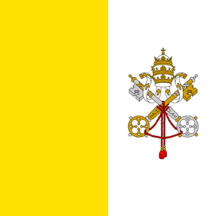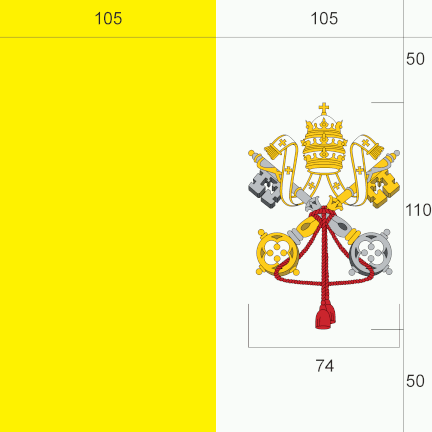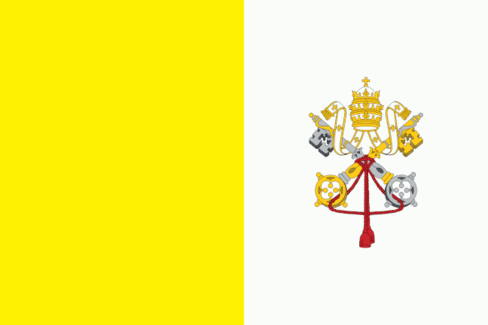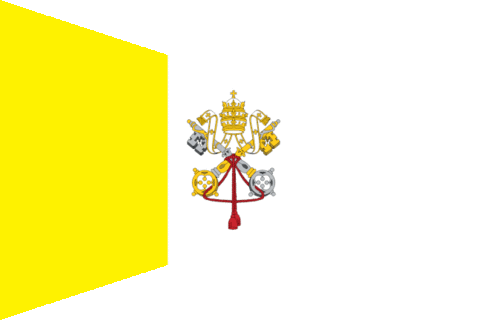 (1:1)
(1:1)
 image located
by Zoltan Horvath, 16 December 2024
image located
by Zoltan Horvath, 16 December 2024
Last modified: 2025-06-07 by rob raeside
Keywords: vatican |
Links: FOTW homepage |
search |
disclaimer and copyright |
write us |
mirrors
 (1:1)
(1:1)
 image located
by Zoltan Horvath, 16 December 2024
image located
by Zoltan Horvath, 16 December 2024
Official Name: The Holy See (State of the
Vatican City) - Santa Sede (Stato della Citta del Vaticano)
Flag adopted: 8
June 1929 (Introduced in 1825)
Coat of Arms adopted: 7 June 1929
Part I (this page):
Part II (next page):
See also:
Other sites:
There seem to be a confusion between the Vatican City State,
the minuscule state that exists only since 1929, and the Holy See
(of Rome), which is the entity which is active in all
international relationships except those of a clearly territorial
nature, such as membership of UPU (Universal Postal Union),
INTELSAT, CEPT and UNIDROIT (International Institute for the
Unification of Private Law).
No government would have much interest in relations with so tiny a state as
Vatican City but 172 states maintain diplomatic
relations with the Holy See, and half of those that have
accredited their ambassador to the Holy See find it worthwhile to
have him or her resident in Rome, distinct from their ambassador
to the Italian Republic.
The flag of the Vatican City State is as on your webpage, showing
the arms with the silver key in the dexter position. When
what is represented is the Holy See, not Vatican City State, the
keys are reversed. Rather, when the state was set up in
1929, the keys in the arms of the Holy
See, with the gold one in dexter position, were reversed to
provide a distinctive symbol for the new entity. In the
personal arms of the popes, the keys are, of course, arranged as
in the arms of the Holy See: the other arrangement would be
equivalent to treating him as merely the head of that little
state. The arrangement for the Holy See is seen on Arms of John Paul II.
Rather than "the keys of paradise", as given on your
page, the reference would be better expressed exactly as in
Jesus' words to Peter in St Matthew's Gospel 16:19 "I will
give you the keys of the kingdom of heaven."
I doubt too the exactness of the description given of the papal
flag in use before the Napoleonic occupation of Rome. The
flag used then was that of the city of Rome, which, if I rightly
recall what is today displayed in Rome, is not "yellow and
red" but gold (yellow) and purple, as it no doubt was also
in 1848 and before 1808.
"nuntius", 14 February 2000
The Vatican has citizens (1500 persons), but there is nobody
with only Vatican citizenship. For example, the Pope is citizen
of both the Vatican and Poland. The other peculiarity is that the
Vatican issues only diplomatic passports, so this is a country,
where all the citizens are diplomats.
Maxval, 14 March 2001
I would suppose the Holy See could be considered to be part of
the government of the Vatican City State, which does have a small
territory.
Elias Granqvist, 15 March 2001
US Department of State's background notes on the Holy See
explain the situation this way:
"The term "Holy See" refers to the composite of
the authority, jurisdiction, and sovereignty vested in the Pope
and his advisers to direct the worldwide Roman Catholic Church.
As the "central government" of the Roman Catholic
Church, the Holy See has a legal personality that allows it to
enter into treaties as the juridical equal of a state and to send
and receive diplomatic representatives. The Holy See has formal
diplomatic relations with 166 nations, including the United
States. Libya, Guyana, and Angola established diplomatic
relations in 1997. Created in 1929 to administer properties
belonging to the Holy See in Rome, the State of the Vatican City
is recognized under international law and enters into
international agreements. Unlike the Holy See, it does not
receive or send diplomatic representatives."
Joe McMillan, 15 March 2001
I notice that the Vatican is listed as "Holy See" in
a list of UN observers at the UN site. Is this used as an
alternative name only, or does it imply something else- more of a
supernational organization, the Catholic Church perhaps? It is
listed as a "non-member state".
Nathan Lamm, 1 October 2002
Holy See is the center of the Catholic church, while Vatican City State is
the territorial unit where Holy See is placed. (the situation is much more
complicated, as Holy See not *the* state is a subject of diplomatic recognition.
See web page of the Holy See's observer mission to UN.) The HS is not a member
of UN (and does not want to become a member). Again - see the web page: www.holyseemission.org.
Jan Zrzavy, 1 October 2002
"In the period between the annexation of the Papal State
by Italy in 1870 and the restoration of its temporal sovereignty
in the Lateran Treaty of 1929, the Holy Sea concluded treaties
(in the form of concordats) and entertained diplomatic relations
with the great majority of States. It was to that extent a
subject of international law without being a State in the
accepted sense of the term." (International Law; Collected
Papers of Hersch Lauterpacht).
David Prothero, 29 December 2002
Vatican has 44 hectares of area + 13 other dependencies of
which Castel Gandolfo who has 7 km2, if I remember well. The Holy
See of whom Vatican is the head territory (Vatican is not
strictly equal to Holy See), is the remnant of the Church States.
Jean-Marc Merklin, 28 December 2002
Crampton (1990) states that
the yellow and white used today date from 1808. Before that,
yellow and red were used. However, I'm reading Trevelyan's Garibaldi
and the Defence of the Roman Republic at the moment and that
source clearly describes the Papal colours in 1848 as still being
yellow and red.
Roy Stilling, 13 May 1996
From Smith (1975): 'In the
whole middle age red was the colour of Catholic Church, and gold
was used for the crossed papal keys. Napoleon mixed his army with
papal, so pope Pius VII decided new colours should be found.'
Pius VII choose gold and silver, and those were accepted in 1825.
The flag was used until 1870, when the state was integrated into
Italy. When the City of Vatican was formed as separate state, it
took the same flag in 1929.
Željko Heimer, 16 May 1996
According to 'Pavillons nationaux et marques distinctives' [Payrat (2000)] - State Flag
(CSW/--- (1:1)) - Vertically divided yellow-white with the keys
emblem in the middle of the last. The image above matches very
well to the 2000 Album issue, here the construction sheet is
given as (1+2+1):(2+2), i.e. the hight of the keys emblem is half
the flag hoist. There are minor differences in keys emblem, but
they are of no significance, I believe - every representation of
the keys is somewhat differently stylized, and I do not believe
that there exists a preffered or official one.
The 2003 correction have the emblem set to larger then half the
hoist (8/23), or if you prefer the "rational"
expression (15+16+15):(23+23). Here the keys are again somewhat
differently stylzed then in 2000 issue, notable, they include a
cross thoughout the key rings, otherwise very much the same. I
don't know what was reason for the change, possibly some document
from Vatican was received by Armand lately.
Željko Heimer, 14 August 2003
The corr. 3. gives a new construction details of the VA flag
(even though the image there does not follow it). The size of the
emblem in the white field is just a bit larger then one third of
the height, so (15+16+15):(23+23).
Željko Heimer, 25 December 2003
According to the Legislation, Album 2000
original issue is correct and the Corr. 3 is not. I should have
pointed out, the 2:3 is an unofficial variant (to match the
official one), and as such surely would come in many versions.
The 1:1 is the only official one.
Željko Heimer, 11 October 2004
On 14 July 2008, the Catholic News Agency (CNA) summarized
an article published a week earlier in
"L’Osservatore Romano" by the historian Claudio
Ceresa, as follows:
"[...] In an article entitled, “Two centuries of yellow
and white as the papal colors,” Ceresa explained that in
order to understand why the colors were chosen, one must consider
the “occupation of the city by Napoleonic troops in February
of 1808.”
“The commander of the French forces, General Miollis, posted
notices on the walls informing that the Pope’s army would be
incorporated into the imperial forces. Those officials who
remained loyal to Pius VII were to be arrested and
deported,” Ceresa explained. “Reaction was
minimal because it was reported that the Pontiff was aware and
did not resist. Only a small group of loyalists were deported to
a prison in Mantova.”
“In order to underscore the unification, and probably to
increase the situation of uncertainty as well,” Ceresa
continued, “the papal soldiers were allowed to continue
using the distinctive yellow-red colors on their hats.”
Ceresa afterwards noted that the Pope “did not want the
Vatican State to be subject to Napoleon, and therefore on March
13, 1808 he forcefully protested. He ordered, among
other things, that the units that were still loyal to him
substitute the Roman insignia colors with white and yellow.”
Abbot Luca Antonio Benedetalla wrote in his diary on the same
date that “in order not to confuse the Roman soldiers who
were under French command with the few that remained in his
service, the Pope ordered the new yellow and white insignia. The
noble guard and the Swiss have adopted it. They like it,” he
wrote.
Ceresa explained that three days later, on March 16, 1808, Pius
VII sent the order in writing to the diplomatic corps, the
document is considered to be the act creating the colors of the
current flag of Vatican City.”
Ivan Sache, 17 July 2008
An article on Vatican flag specimens:
https://www.catholicnewsagency.com/news/254032/wikipedia-had-the-wrong-vatican-city-flag-for-years-now-incorrect-flags-are-everywhere
William Becker, 8 April 2023
The flag was slightly modified in an updated constitution in 2023. The new
flag image is online at:
https://press.vatican.va
The full constitution is online at:
https://www.vatican.va/content
William Becker, 20 February 2024
 image by Željko Heimer, 11 October 2004
image by Željko Heimer, 11 October 2004
Note: this flag shows colors of a common variant of the Vatican flag, with
the keys in the same shade of yellow as the hoist half, and a red center to the
tiara.
William Becker, 8 April 2023
Vatican City has again updated its constitution (effective June 7), with
minor revisions to the images of its flag and arms. The flag annex illustration
is here:
https://press.vatican.va/content/dam/salastampa/it/bollettino/documentazione-linkata/allegato_A.pdf
The full constitution is here:
https://www.vatican.va/content/francesco/it/motu_proprio/documents/20230513-legge-fond-scv.html
A news article is here:
https://www.ncronline.org/vatican/vatican-news/popes-new-fundamental-law-vatican-city-allows-laypeople-serve-governing-body
William Becker,
July 2024
 image by Zoltan Horvath, 16 December 2024
image by Zoltan Horvath, 16 December 2024
The 2:3 unofficial variant (C--/-- (2:3)) is certainly used
sometimes in "civil use", i.e. when it serves mere
ornamental purpose more then statehood one. The 2000 issue give
here also construction details (1+2+1):(3+3), but this surely
must be orientational - the flag is unofficial anyway. The 2003
issue removes this construction details. See: Non-Square
Flags.
Željko Heimer, 14 August 2003
The unofficial variant in 2:3 is also shown, in corr. 3
without the construction details (in original 2000 issue it had
details, but these are now removed, presumably no sense in
determining construction details for an unofficial flag). The
details were in effect so that the height of the emblem is half
the flag height.
Željko Heimer, 25 December 2003
All of the flags I saw on the street and on television during
the recent papal visit (including in front of the White House in
Washington DC), were of the unofficial 2:3 variation.
Roger Moyer, 5 May 2008
As explained here, nothing in the
official description of the flag requires it to be square, that
the version illustrated in the law is the one that is carried as
an infantry color and actually is square, but
that flags hoisted in Vatican City are generally not
square but rather 2:3.
Joe McMillan, 14 May 2008
I beg to disagree. Below is the legislation
that both established and confirmed the flag - the Acts of 1929
and 2001 state in Article 20 that:
"1. The flag of the City of the Vatican consists of two
fields divided vertically, yellow field on the staff side and a
white field on the other side, which bears the tiara and the
keys, the whole following the Model A annexed to the present
law."
I then go on go give the details of Model A both of which (I now
have copies of) show a flag in proportions of 1:1.
Neither of these Laws relate to a military colour but to the
"flag of the City of the Vatican", so I would suggest
that 1:1 are indeed the 'official' proportions and our comments
thus justified by written source.
However, we have a first hand account (and my own notes taken
verbatum from those of William Crampton) that flags with
proportions of 2:3 are in use by the Vatican City State, so such
flags are known to be in use as a variant.
Christopher Southworth, 15 May 2008
As it happens, we have the image
from the constitution, courtesy of Fr. Becker. As can be
seen, nothing on the graphic indicates dimensions. Obviously,
since there is a drawing, ratio-hungry vexillologists
instinctively interpret that as the one and only correct
ratio. But by that logic they would also have to
conclude that the flag must always be displayed with a spearhead
finial, a spiral-striped pole, and a yellow-and-white cravat
attached above the upper hoist!
It seems to me that if neither the text nor the picture specify a
ratio, whether explicitly or implicitly, then we must conclude
that there is no official ratio.
Joe McMillan, 15 May 2008
I must still beg to disagree. To me a flag defined by
illustration remains defined - and the wording of both Legal
instruments specifically state that it is so - regardless of
whether that illustration actually contains figures or it does
not.
The point with regard to the cravat, finial and pole
is cogently argued and well taken, but may I suggest that these are designed to
show the flag in in its highest degree of ceremonial presentation (similarly to
those flags of US states which are defined as having a fringe which is never
used in general practice)
Christopher Southworth, 16 May 2008
The Fundamental Law of the Vatican City State issued on 13 May 2023 defines
the flag and coat of arms with illustrations:
https://www.vaticanstate.va/phocadownload
This 2023 flag is very
similar to the flag used in the 1929 Fundamental Law of Vatican City State:
https://www.vaticanstate.va/phocadownload (page 35)
The Album des Pavillons 1990 [pay98] gives approximate colors in Pantone and
CMYK systems:
Yellow: Pantone 116c, CMYK 0-10-95-0
Red: Pantone 186c, CMYK 0-90-80-5
The Olympic Flag Manuals are not relevant, they dont illustrate its flag,
while Vatican are not member of IOC.
The Album des Pavillons 2000 [pay00]
(Corr. No. 5.) gives approximate colors in Pantone and CMYK systems:
Yellow:
Pantone 116c, CMYK 0-10-95-0
Red: Pantone 186c, CMYK 0-90-80-5
The
Album des Pavillons 2023 specifies the colors of the flags in three color
systems:
Red: Pantone 186c, CMYK 10-100-74-2, RGB 210-16-52
Yellow:
Pantone 116c, CMYK 0-19-93-0, RGB 255-206-0
Vexilla Mundi gives colors in Pantone system:
PMS White, PMS Yellow C, PMS 118C (golden), PMS 428C (silver), and PMS 186C
(red).
Wikipedia illustrates the flag, and
construction details, but doesnt give any color specification.
Flag Color Codes gives the
following color values:
Yellow: Hex #FFF200, RGB 255-242-0, CMYK 0-5-100-0,
Pantone
803 C, RAL 1026
Dark Yellow: Hex #FFCC20, RGB 255-204-32, CMYK
0-20-88-0, Pantone 123 C, RAL 1018
White: Hex #FFFFFF, RGB
255-255-255, CMYK 0-0-0-0, Pantone N/A, RAL N/A
Light Grey: Hex
#BDBEC0, RGB 189-190-192, CMYK 2-1-0-25, Pantone P 175-2 C, RAL 7035
Grey:
Hex #515356, RGB 81-83-86, CMYK 6-3-0-66, Pantone 445 C, RAL 7015
Gold: Hex #A88D37, RGB 168-141-55, CMYK 0-16-67-34, Pantone 456 C, RAL 1024
Red:
Hex #C9252C, RGB 201-37-44, CMYK 0-82-78-21, Pantone
711 C, RAL 3028
Zoltan Horvath, 16 December 2024
.gif) image located by Zoltan Horvath, 16 December 2024
image located by Zoltan Horvath, 16 December 2024
Source: https://en.wikipedia.org/wiki/Vatican_City
seal.gif) image located by Zoltan Horvath, 16 December 2024
image located by Zoltan Horvath, 16 December 2024
The seal of the State bears the tiara with the keys in the center of the disc
and legend is the name the state "Stato della Città del Vaticano (State of the
Vatican City).
Zoltan Horvath, 16 December 2024
 image
by Zoltan Horvath, 16 December 2024
image
by Zoltan Horvath, 16 December 2024
The yellow-white pennant used on motor vehicles carrying John
Paul II bears his personal arms on the white stripe (i.e., his
personal shield-of-arms supported by the tiara-keys emblem, See:
The Car Pennant of Pope Paul VI),
not the simplified tiara-keys emblem.
Rev. William M. Becker, STD, 30 June 2004
Flag seen at
https://www.gettyimages.dk
Zoltan Horvath, 16 December 2024
The Holy See, naturally, doesn't have an air force. As far as I know it
doesn't even have planes. However, when the pope is taking a flight, his arms
appear next to the front door of the plane. See: www.airliners.net/351454, www.airliners.net/261961
and www.airliners.net/522829.
It seems that those arms are left on the plane afterwards as a
declaration "The Pope flew in this plane" as seen on
the out-of-service ex-Viasa plane at www.airliners.net/484315.
Dov Gutterman, 28 June 2004
The pope travel only in "Catholic" airlines. When he
visit a "Chatolic" state he uses the local flag carrier
airline to his flight. If there are more then one flag-cattier,
he don't insult anybody and used all of them.
In his visit to Mexico, the pope JP II used Mexicana on one way
and Aero-Mexico on the other
It seems that the pope emblem is not removed afterwards and the
plane still carry it as a token and to show that this is a
"papal plane".
When visiting a non-Catholic state, the pope use Alitalia planes.
Dov Gutterman, 4 July 2007
The (larger) Vatican flags seen displayed over Jordan and
Israel during the Pope visit , appeared to be 1:2 rather than
1:1. Some of them as banners.
Santiago Dotor, Jorge Candeias and Dov
Gutterman, 21 March 2000
I see vatican flags in 1:2 ratios constantly. This has
to do with the fact that I went to Catholic Primary and Secondary
Schools, my sister went to a Catholic Primary School, and so is
my brother. Overall, the three of us have attended (or are
attending) 4 different schools. The reason for the
Vatican's flag is that, as a Catholic school, our teaching falls
under the "jurisdiction" of the Vatican. And
since Canada has the law about all flags being the same size as
the Canadian flag, the Vatican's flag is stretched to be 1:2.
Georges G. Kovari, 25 February 2002
In the States the Vatican flag is seen in 2:3 and 3:5, being
made to fit with the standard sizes manufactured by US flag
makers. In our church the US and Vatican flags are 4 foot by 6
feet, i.e. 2:3.
Devereaux Cannon, 25 February 2002
 image
by António Martins-Tuválkin, 24 April 2005
image
by António Martins-Tuválkin, 24 April 2005
In a Vatican flag-waving crowd Reuters photo, a horizontal
bicolor of yellow over white.
António Martins-Tuválkin, 24 April 2005
Such vertical bicolours (and also longitudinal bicolours of
vertically hanging banners) are not an unusual sight on churches
at least in central Europe, I guess from the Baltic to the
Adriatic sea. This especially where the horizontal bi- (and tri-)
colours are national flags, making probably a better visual
effect then if the proper VA flag would be used.
Željko Heimer, 24 April 2005
Seen at the Austrian Hospice in the Old City of Jerusalem: two flags - the
Austrian (no arms) and a horizontal yellow/white. There are standard Vatican
flags elsewhere in the area, particularly on various churches, so I thought the
presence of this one was interesting, particularly as it's a semi-"official"
Catholic institution.
Nachum Lamm, 4 April 2010
For continuation see Part II